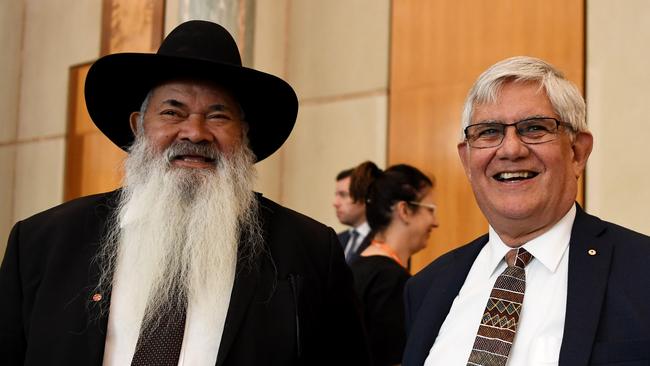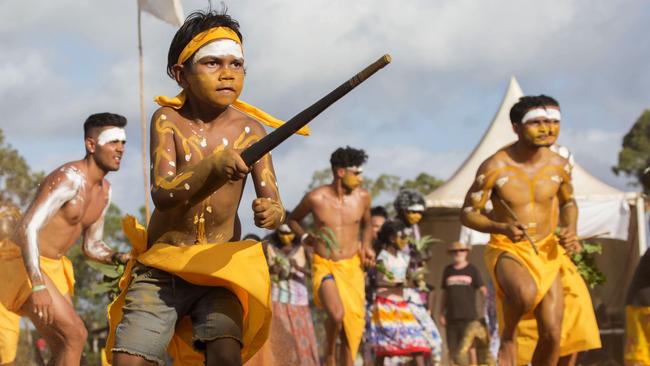Ministers present but indigenous voice muffled
The federal government continues to deny indigenous Australians their desired status in the general community.

The scenario was unprecedented: Australia would have an indigenous minister for indigenous affairs for the first time, regardless of who won the May election.
Almost 50 years after Neville Bonner arrived in Canberra as a Queensland senator and the first indigenous person to enter federal parliament, the Coalition and Labor both entered the 2019 campaign intending to appoint a First Nations minister.
The symbolism of this win-win alignment means a lot to former schoolteacher and health bureaucrat Ken Wyatt, who became Minister for Indigenous Australians when the Coalition was returned. The 67-year-old Noongar man’s childhood memories include moving with his parents and siblings to the West Australian wheatbelt town of Corrigin, where some locals circulated a petition to try to have “the new Aboriginal family” kicked out.
Wyatt’s friend Linda Burney, also a former schoolteacher, became the opposition spokeswoman in the indigenous Australians portfolio. The 62-year-old is a member of the Wiradjuri nation as well as the first Aboriginal person elected to the NSW parliament.
Wyatt has asked Burney and a cross-section of political colleagues and opponents to work with him on the task of guiding parliament towards a referendum on constitutional recognition of indigenous Australians and a legislated indigenous voice.
It is where the government is leading Australia after two prime ministers, Malcolm Turnbull and Scott Morrison, rejected the landmark Uluru Statement from the Heart’s call for a constitutionally enshrined indigenous voice to parliament. Both claimed the 2017 document set out what would be a “a third chamber”, though two former chief justices of the High Court say this is not correct.
One of the parliamentarians in Wyatt’s working group is Liberal Celia Hammond, who was once in charge of the only university in Australia that did not fly the Aboriginal flag on campus. Hammond and the board of Notre Dame University were in agreement that to do so would be tokenism.
Not long after Hammond’s appointment as vice-chancellor of the Catholic university in 2008, she received a long letter that changed her mind. It was from an indigenous woman who worked at the university’s Broome campus in the far north of WA.
“It really struck a chord with me because it was about symbolism,” Hammond said during a panel discussion of Liberal female MPs in Perth on December 11.
“The message that was put to me was, ‘When we walk on to the campus and there is nothing there, you tell us that we are welcome but there’s nothing that is visibly demonstrating that.’ ”
Hammond and the university board reversed their decision. And at some point in the past decade Hammond became a supporter of constitutional recognition, too.
“Symbolic steps without effective action are ultimately pointless and potentially do more harm than good, but symbolic steps can give momentum and effect to concrete actions and initiatives,” she said in her maiden speech.
“To that end, I will be fully supporting the efforts towards constitutional recognition of our indigenous peoples and exploring new ways of working together to ensure that the concrete actions and initiatives which are delivered actually work.”
What Hammond touches on has been a subject of near-constant debate and reflection in indigenous affairs across the past decade: the difference between symbolism that does not bind government and structural reform that redistributes power in our legal and political system.
This period has been defined by the constitutional recognition project and the question of whether the nation pursues symbolic acts or change that outlasts the government of the day.
Wyatt tells Inquirer that an overarching acceptance of the need to do more in indigenous affairs is one of the biggest advancements in recent years.
This could be at least in part because the signs that more needs to be done could not be more clear, despite almost 20 years of intensive commonwealth policy work. Suicide remains the leading cause of death for indigenous children aged five to 17, and Aboriginal and Torres Strait Islanders aged between 15 and 24 are almost four times more likely to commit suicide than non-indigenous people the same age.
In 2019 — after a 10-year commitment from states, territories and the commonwealth to close the gap between indigenous and non-indigenous Australians in health, education and employment — only two of seven Closing the Gap targets were on track to be met. The 10th and final report made for depressing reading.
The target to have 95 per cent of indigenous four-year-olds enrolled in early childhood education by 2025 was on track and so was the target to halve the gap in Year 12 attainment or equivalent by 2020.
But a target to halve the gap in mortality rates between indigenous and non-indigenous children was not on track, nor were targets to close the gap in school attendance rates and life expectancy. The targets to halve the gap in reading and numeracy and halve the gap in employment were not on track.
The Morrison government scrapped the targets and started again in consultation with peak indigenous groups. It was an admission of failure that some also saw as hopeful, particularly when the newly formed National Indigenous Australians Agency declared that real change will come through community-led solutions that engage Aboriginal and Torres Strait Islander peoples “to pursue their own visions of what makes for a good life, to be healthy, prosperous, and secure”.
These words on the website of the agency under Wyatt’s direct control do not impress constitutional lawyer Megan Davis, a Cobble Cobble Aboriginal woman from the Barrungam nation in southwest Queensland who, as a member of the Referendum Council, led the 13 dialogues with 1200 indigenous people that culminated in the Uluru statement. An indigenous rights expert member of the UN Human Rights Council and professor of law at the University of NSW, Davis says it is disingenuous for the NIAA to say real change will come through community-led solutions because “the structures are not set up to achieve this”.
“This is what the Uluru statement said. It is a contemporary trend of bureaucrats to co-opt the language of ‘self-determination’ and espouse enthusiasm for grassroots communities’ vision for the ‘good life’,” Davis says.

“They don’t mean it. If they did, they would support the voice to parliament because it was the culmination of grassroots, representative dialogues that dismissed symbolism and called for a seat at the table, a voice, a hard-headed structural reform that compels the government to listen to grassroots and cuts out the mercurial nature of electoral cycles and the Florentine patronage system of bureaucrats and successive ministers.
“Being compelled, forced, to listen is why they support a ‘voice to government’ rather than a ‘voice to parliament’. It shores up their own power and the status quo. When they talk about supporting visions of the good life, they are talking about their own.”
Wyatt describes “the general broad acceptance of constitutional recognition” as a significant change since a lengthy process that began in 2007 when then prime minister John Howard said: “I believe we must find room in our national life to formally recognise the special status of Aboriginal and Torres Strait Islanders as the first peoples of our nation.”
Years of careful work followed. In 2010, then prime minister Julia Gillard appointed the Expert Panel on the Recognition of Aboriginal and Torres Strait Islander Peoples in the Constitution, co-chaired by Patrick Dodson and Mark Leibler. Then came the Commonwealth Act of Recognition that led to the review by John Anderson. Next was a Joint Select Committee on Constitutional Recognition of Aboriginal and Torres Strait Islander Peoples co-chaired by now Minister for Indigenous Australians Wyatt and then Labor senator Nova Peris.
After that, the Referendum Council ran 13 dialogues with 1200 indigenous people around Australia. Following that, the next joint select committee chaired by Dodson and Julian Leeser presented a clear case for the voice. It recommended that “following a process of co-design, the Australian government consider, in a deliberate and timely manner, legislative, executive and constitutional options to establish the voice”.
Dodson is among indigenous leaders who sees a voice to parliament as a moderate proposal. He tells Inquirer he is confounded by how an essentially conservative proposal ended up being painted as radical. “There was nothing in the Uluru statement that contained an intention to bind parliament … it was asking for an advisory body,” he says.
The compromise now being explored by the Morrison government is a multi-layered structure that serves as a voice to the whole of government, not parliament. The co-design of this version of the voice is co-chaired by highly respected indigenous leaders Marcia Langton and Tom Calma. They are committed to finding a model for the voice that gives indigenous people strong representation. They began their work last month amid fears that the model ultimately approved by this government could end up formalising bureaucracy’s power over indigenous affairs.
Dodson appears more pessimistic than ever. “The government is going to spend $7.3m leading people up the garden path again,” he says. “What we are doing is regularising the status quo.”
Uluru signatories made a point of presenting their statement to the people of Australia rather than to the government as they felt politicians did not listen to them. Now they are focused on winning over the public.
Some see parallels with the grassroots campaign that led to bipartisan support for the 1967 referendum. Cape York leader Noel Pearson describes a constitutionally enshrined voice as “positive recognition”.
In a speech to the annual gala dinner of the Law Council of Australia in Canberra last month, he said the question was “whether 65,000 years of presence on this continent should count for anything in the modern Australian commonwealth and its future … Or should the most recent 250 years of British dominion over this land be all that really counts?”
Pearson said Cook’s failure to come to terms with principles of English law about possession of land then fell upon every subsequent generation of Australians to reckon with as unfinished business.
“Let me briefly rehearse the main grounds for objection to positive recognition, through the proposition of the indigenous voice enshrined in the Constitution,” Pearson said.
“The first objection concerns the question of race. It is alleged the voice would be a racial insertion into the Constitution. This is the standard argument of Andrew Bolt and the Institute of Public Affairs. This objection is only possible through a dishonest conflation of indigeneity with race. The IPA maintains recognition is racial recognition rather than a recognition of the fact that Aboriginal and Islander peoples are indigenous to this nation. If our people were blonde and blue-eyed like the Sami of the Arctic Circle it would be readily apparent recognition has nothing to do with race.
“The second objection concerns equality under the Constitution and was best disposed of by former chief justice Murray Gleeson — which stands as the indispensable and the best case for indigenous constitutional recognition. In this Australian history of refusal to come to terms with the truth, of course terra nullius took so long for the country to come to terms with, to confront and to dispose of its horrific lie.”
If the right to self-determination exists not just for individuals and tribes but as a national indigenous polity, Pearson says the Uluru process represents the highest benchmark in terms of process, dialogue and consensus.
“Uluru called for three things: for a voice in the Constitution, for treaty in the form of a Makarrata supervised by a Makarrata commission, and the telling of truth: to bring Australians together in a shared understanding of their past and a conviction that we can only envision a shared future for ourselves,” he said.
Pearson urges hope, belief and says “this is not the time for pessimism, we have real prospects, we can make this a positive moment for Australia”.




To join the conversation, please log in. Don't have an account? Register
Join the conversation, you are commenting as Logout